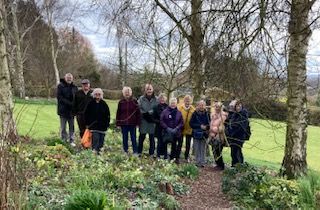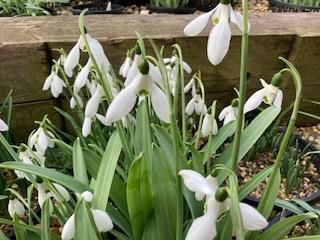Spring Platt February 2022

On Tuesday 8 February a group of 15 from our Garden of Edenbridge group visited Spring Platt, Sutton Valance to view over 400 species of snowdrops. Galanthus is the family name for all snowdrops and the most important are Galanthus Nivalis, Elwesii and Plicatus. Together they are the ancestors of almost all known snowdrops. The most common is the Galanthus Nivalis, meaning ‘Milk Flower of the Snow’. Galanthus Plicatus is known as the ‘Pleated Snowdrop’ and Galanthus Elwesii was named after Henry John Elwes, a Victorian traveller and plant hunter. He found this giant snowdrop in Turkey. Today, although not native to this country, it’s commonly found in the British Isles rearing its pearly head in time to coincide with the celebration of Candlemass around the beginning of February.
An excerpt from an old English calendar dating back to the 19C reads:
“The Snowdrop, in purist white arraie
First rears her head on Candlemass daie
While the Crocus hastens to the shrine
of Primrose lone on St. Valentine”
And the Scottish poet George Wilson concludes his poem ‘The Origin of the Snowdrop’ with the lines:
“And thus the Snowdrop, like the bow
That spans the cloudy sky
Becomes a symbol whence we know
That brighter days are nigh”

So, back to Spring Platt’s one-acre beautiful garden with its far-reaching panoramic views over the High Weald. We visited on a very windy day, sadly for us as it was sandwiched between two sunny days. But hardy explorers as we are, and with the warmth of a welcome cup of coffee or tea, we continued our adventure. Carers of these pretty and hypnotic flowers, Caroline and daughter Julie took us round explaining all about the way they cultivate and increase the over 400 different species. They ’Chip’ the bulbs (essentially dividing a bulb into smaller pieces) to increase from 1 or 2 of one variety to around 15-20. A surprise to me was that some plants can fetch up to £40 each! They are planted largely with sand into pond containers rather than directly into the soil to stop the bulbs from ‘walking’ and therefore alleviate crossing with other species. The baskets are placed into raised terraces creating a waterfall effect. Added to this spectacle was an array of Alpines filling one of the many greenhouses, and waves of yellow aconites swaying in the flower beds. Chilled, and after a very interesting tour, we were ready to find the summer house for much needed homemade soup and homemade bread.
Stephanie King
